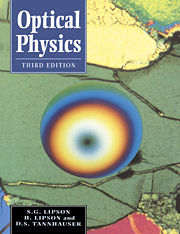Book contents
- Frontmatter
- Contents
- Preface to the third edition
- Preface to the second edition
- Preface to the first edition
- 1 History of ideas
- 2 Waves
- 3 Geometrical optics
- 4 Fourier theory
- 5 Electromagnetic waves
- 6 Polarization and anisotropic media
- 7 Diffraction
- 8 Fraunhofer diffraction and interference
- 9 Interferometry
- 10 Optical waveguides and modulated media
- 11 Coherence
- 12 Image formation
- 13 The classical theory of dispersion
- 14 Quantum optics and lasers
- 15 Problems
- Appendix 1 Bessel functions in wave optics
- Appendix 2 Lecture demonstrations in Fourier optics
- Bibliography
- Index
7 - Diffraction
- Frontmatter
- Contents
- Preface to the third edition
- Preface to the second edition
- Preface to the first edition
- 1 History of ideas
- 2 Waves
- 3 Geometrical optics
- 4 Fourier theory
- 5 Electromagnetic waves
- 6 Polarization and anisotropic media
- 7 Diffraction
- 8 Fraunhofer diffraction and interference
- 9 Interferometry
- 10 Optical waveguides and modulated media
- 11 Coherence
- 12 Image formation
- 13 The classical theory of dispersion
- 14 Quantum optics and lasers
- 15 Problems
- Appendix 1 Bessel functions in wave optics
- Appendix 2 Lecture demonstrations in Fourier optics
- Bibliography
- Index
Summary
Occurrence of diffraction
As we saw in Chapter 1, the wave theory of light was not at first generally accepted because light did not appear to have any obviously wave-like properties; for example, it did not bend round obstacles as water waves are clearly seen to do. The reason why this difficulty no longer prevents our acceptance of the wave theory is that we are now aware of the relative scales of the two sorts of waves: water waves are coarse and we can see that they only bend round obstacles that have dimensions of the same order of magnitude as the wavelength; larger objects merely stop the waves in the sense that the waves bending round the edge produce negligible effects. But the wavelength of light is about 5 × 10-7 (0.5 μm) and an object of about a hundred waves in size – sufficient to stop a light wave – is still very small by ordinary standards. Nevertheless some bending of the light waves round the edges of obstacles does occur and can be observed over a range of conditions. For particles of the order of a few wavelengths in size, no special apparatus is needed; for example, the water droplets that condense on a car window are surprisingly uniform in size and show beautiful halos round the street lights as the car passes by. For objects that are much larger, special apparatus is needed. The effects are called diffraction phenomena.
- Type
- Chapter
- Information
- Optical Physics , pp. 152 - 175Publisher: Cambridge University PressPrint publication year: 1995
- 1
- Cited by



